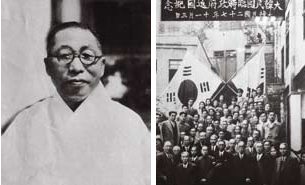March 1 movement in South Korea in 1919
The March 1 Movement, also known as the Sam-il
Movement (3-1) (Hangul: 삼일
운동)
was one of the earliest public appearances of Korean resistance during the
Korean rule by Japan from 1910 to 1945. His name refers to events that occurred
on March 1, 1919, the name of the movement literally means "Three-One
Movement" or "March First Movement" in Korea. This is also
sometimes referred to as the Man-se Demonstration (Korean: 만세
운동
Manse Undong).
The Samil Movement emerged as a reaction to the
oppressive nature of colonial rule under the de facto military rule of the
Japanese Empire after 1905, and was inspired by "Fourteen Points"
which outlined the national "self-determination" national rights,
which was proclaimed by President Woodrow Wilson at the Paris Peace Conference
in Paris January 1918. After hearing news of Wilson's speech, Korean students
studying in Tokyo issued a statement demanding freedom from the colonial
government.
The former Emperor Gojong died on January 21, 1919.
There was widespread suspicion that he had been poisoned, believed since his
previous attempts ("coffee fields") were famous, and other leaders
had been killed by Japanese agents
At 2 pm on March 1, 1919, 33 activists who formed
the core of the Samil Movement met at the Taehwagwan Restaurant in Seoul; they
read out the Korean Declaration of Independence, compiled by historian Choe
Nam-seon. Activists originally planned to gather at Tapgol Park in central
Seoul, but chose a more private location for fear that the meeting would turn
into riots. Movement leaders signed documents and sent copies to the
Governor-General.
CONTENTS OF THIS MOVEMENT:
We hereby declare the independence of Korea and the
freedom of the Korean people. We convey this to all nations of the world as a
witness to human equality. We convey this to our descendants so that they can
enjoy forever their inherent right to nationality. Just as this proclamation
comes from our five thousand year history, as much as it comes from the loyalty
of twenty million people, as much as it confirms our desire to advance eternal
freedom, as does independence. expressing our desire to take part in global
reforms rooted in human conscience, that is the will of heaven, the great waves
of our time, and the just actions needed for the co-existence of all humanity.
Therefore, there is no power in this world that can block or suppress it!
The March 1 Movement provided a catalyst for the
Korean Independence Movement, which was crucial for the spread of the Korean
independence movement to other regional governments, including Hoengseong.
Because of the subsequent suppression and the hunt for activists by Japan, many
Korean leaders went into exile in Manchuria, Shanghai and other parts of China,
where they continued their activities. This movement was a catalyst for the
formation of the Provisional Government of the Republic of Korea in Shanghai in
April 1919. The movement also influenced the growth of nonviolent resistance in
India and many other countries.
The Korean Liberation Army was later formed
and permitted to operate in China by the Chinese Nationalist Government. During
this period, there was mobilization of Catholic and Protestant activists in
Korea, with activism encouraged among the diaspora in the US, China, and
Russia.
The Japanese government reacted to the March 1
Movement by heightening its suppression of dissent and rejecting the Movement
as "The Chosun Pastor Public Disruption Incident" (조선
공공
만세
폭력
사건).
Governor-General Hasegawa Yoshimichi accepted responsibility for the loss of
control (although most of the repressive actions that led to the uprising had
been put in place by his predecessors); he was replaced by Saito Makoto.
Military police were replaced by civilian troops.
Limited press freedom is
permitted based on what is called 'cultural policy'. Many of these soft
policies were reversed during the Second Sino-Japanese War and World War II.
On May 24, 1949, South Korea declared March 1 a
national holiday. General Choe Hong-hui dedicated the first of three patterns (삼일
틀
- Sam-il teul) which were trained by the taekwon-do level III black belt for
the Sam-il Movement.











Komentar
Posting Komentar